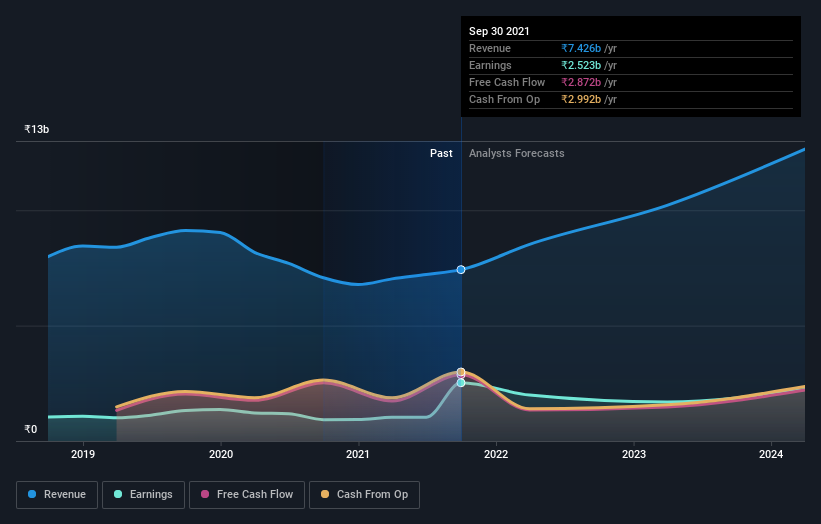- India
- /
- Electrical
- /
- NSEI:TRITURBINE
What Does Triveni Turbine Limited's (NSE:TRITURBINE) Share Price Indicate?

While Triveni Turbine Limited (NSE:TRITURBINE) might not be the most widely known stock at the moment, it led the NSEI gainers with a relatively large price hike in the past couple of weeks. With many analysts covering the stock, we may expect any price-sensitive announcements have already been factored into the stock’s share price. However, what if the stock is still a bargain? Today I will analyse the most recent data on Triveni Turbine’s outlook and valuation to see if the opportunity still exists.
See our latest analysis for Triveni Turbine
Is Triveni Turbine still cheap?
The share price seems sensible at the moment according to my price multiple model, where I compare the company's price-to-earnings ratio to the industry average. In this instance, I’ve used the price-to-earnings (PE) ratio given that there is not enough information to reliably forecast the stock’s cash flows. I find that Triveni Turbine’s ratio of 23.13x is trading slightly above its industry peers’ ratio of 22.24x, which means if you buy Triveni Turbine today, you’d be paying a relatively sensible price for it. And if you believe that Triveni Turbine should be trading at this level in the long run, then there should only be a fairly immaterial downside vs other industry peers. Furthermore, it seems like Triveni Turbine’s share price is quite stable, which means there may be less chances to buy low in the future now that it’s priced similarly to industry peers. This is because the stock is less volatile than the wider market given its low beta.
What kind of growth will Triveni Turbine generate?

Investors looking for growth in their portfolio may want to consider the prospects of a company before buying its shares. Although value investors would argue that it’s the intrinsic value relative to the price that matter the most, a more compelling investment thesis would be high growth potential at a cheap price. However, with a negative profit growth of -3.8% expected over the next couple of years, near-term growth certainly doesn’t appear to be a driver for a buy decision for Triveni Turbine. This certainty tips the risk-return scale towards higher risk.
What this means for you:
Are you a shareholder? Currently, TRITURBINE appears to be trading around industry price multiples, but given the uncertainty from negative returns in the future, this could be the right time to reduce the risk in your portfolio. Is your current exposure to the stock beneficial for your total portfolio? And is the opportunity cost of holding a negative-outlook stock too high? Before you make a decision on TRITURBINE, take a look at whether its fundamentals have changed.
Are you a potential investor? If you’ve been keeping tabs on TRITURBINE for a while, now may not be the most optimal time to buy, given it is trading around industry price multiples. This means there’s less benefit from mispricing. In addition to this, the negative growth outlook increases the risk of holding the stock. However, there are also other important factors we haven’t considered today, which can help gel your views on TRITURBINE should the price fluctuate below the industry PE ratio.
If you want to dive deeper into Triveni Turbine, you'd also look into what risks it is currently facing. You'd be interested to know, that we found 4 warning signs for Triveni Turbine and you'll want to know about them.
If you are no longer interested in Triveni Turbine, you can use our free platform to see our list of over 50 other stocks with a high growth potential.
Valuation is complex, but we're here to simplify it.
Discover if Triveni Turbine might be undervalued or overvalued with our detailed analysis, featuring fair value estimates, potential risks, dividends, insider trades, and its financial condition.
Access Free AnalysisThis article by Simply Wall St is general in nature. We provide commentary based on historical data and analyst forecasts only using an unbiased methodology and our articles are not intended to be financial advice. It does not constitute a recommendation to buy or sell any stock, and does not take account of your objectives, or your financial situation. We aim to bring you long-term focused analysis driven by fundamental data. Note that our analysis may not factor in the latest price-sensitive company announcements or qualitative material. Simply Wall St has no position in any stocks mentioned.
Have feedback on this article? Concerned about the content? Get in touch with us directly. Alternatively, email editorial-team (at) simplywallst.com.
About NSEI:TRITURBINE
Triveni Turbine
Manufactures and supplies power generating equipment and solutions in India and internationally.
Outstanding track record with excellent balance sheet and pays a dividend.
Similar Companies
Market Insights
Community Narratives



